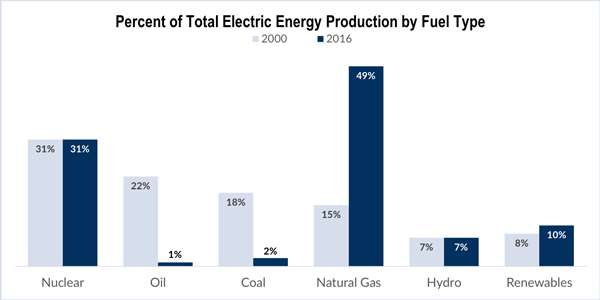By Michael Kuser
ISO New England will open the new year by filing with FERC a two-settlement market construct to integrate state-sponsored renewable energy resources into the wholesale electricity market.
The New England Power Pool’s Participants Committee voted Dec. 8 on the two-tier market concept called Competitive Auctions with Sponsored Policy Resources (CASPR), but with 57.75% of the vote, the proposal failed to reach the 60% mark needed to be considered supported by the PC. Nonetheless, the RTO plans to file the proposal with FERC this month, according to spokesperson Matt Kakley. (See New England Strives to Find CASPR Consensus.) [Editor’s Note: An earlier version of this article incorrectly stated that the vote would be taken in January.]
Under CASPR, ISO-NE would conduct the Forward Capacity Auction in two stages, allowing existing resources that have capacity obligations and a desire to retire to trade out their obligations with incoming state-sponsored resources in a manner that doesn’t affect price formation in the primary auction.
In the primary FCA, resources would clear based on current rules, including those designed to mitigate offers below competitive prices such as state-sponsored resources. In the secondary or substitution auction, existing resources that cleared in the FCA would be able to transfer their capacity obligations to new sponsored policy resources that did not clear, with the existing resource agreeing to retire early in exchange for a “severance” payment.
CASPR, which arose from the Integrating Markets and Public Policy (IMAPP) process begun in 2016, is just one of the electricity policy issues facing New England.
State-Sponsored Renewable Energy
In January, Massachusetts will select the winners of last July’s solicitation for 9.45 TWh/year of hydro and Class I renewables (wind, solar or energy storage). Contracts with the winning bidders under the MA 83D request for proposals are due to be completed in late April.
The proposals include an HVDC transmission line from northern Vermont to New Hampshire to deliver 1,200 MW of new wind power from Canada; a 375-mile submarine HVDC transmission line extending from New Brunswick to Plymouth, Mass.; and a submarine cable under Lake Champlain to bring 1,000 MW of hydropower, solar and wind from Canada. (See Hydro-Québec Dominates Mass. Clean Energy Bids.)
Offshore Wind in Mass.
Three developers submitted proposals Dec. 20 in response to Massachusetts’ solicitation for up to 800 MW of offshore wind energy, offering projects that include a transmission “backbone” and storage to enable them to perform like a baseload resource.
The state’s 2016 Act to Promote Energy Diversity mandates that the Department of Energy Resources and the state’s distribution utilities sign long-term contracts for 1,600 MW of offshore wind by June 30, 2027.
The state’s first RFPs (solicitation 83C) called for a minimum of 400 MW but said the state would consider bids of up to 800 MW if it determines that a larger proposal is superior to and more economical than the others.
The three developers — all with ties to the state’s utilities — have purchased renewable energy leases off the coast from the federal Bureau of Ocean Energy Management. (See Mass. Receives Three OSW Proposals, Including Storage, Tx.)
The state will announce the winners of the offshore wind solicitation on April 23, and contracts are to be submitted at the end of July.
Storage Coming on Strong
As of December, ISO-NE reported more than 470 MW of energy storage in the interconnection queue, a nearly six-fold increase in one year.
Massachusetts is funding incentives to include energy storage in solar installations, as well as grants for peak demand reduction. Pairing energy storage with solar panels is meant to enhance grid resiliency by reducing the need for traditional generation to ramp up when the sun goes down. Peak reduction grants cover a wide range of projects, from utilities improving the efficiency of substations, to municipalities working to reduce the energy consumption of big-box retail stores, to a thermal energy storage project on Nantucket that will delay the need for a new undersea transmission cable. (See Massachusetts Awards $20M in Energy Storage Grants.)
The state in 2017 launched its Solar Massachusetts Renewable Target (SMART) program to provide incentives for “long-term sustainable … cost-effective solar development.” The program provides incentives based on location, and to projects that provide unique benefits, including community solar and energy storage
Massachusetts’s new Alternative Energy Portfolio Standard is the only one of its kind in the country. The final draft regulations, released Dec. 29, include combined heat and power, flywheel storage, renewable thermal, fuel cells and waste-to-energy thermal technologies. The regulations oblige all retail electric suppliers to acquire a percentage of their power from eligible technologies, starting at 4.25% in 2017 and increasing by 0.25% each year through 2020, and by the same amount each year thereafter, subject to DOER review.
Millstone Debate
Opponents of Dominion Energy’s bid to win state subsidies for its Millstone nuclear plant were cheered in December as consultants hired by Connecticut said the plant is likely to remain profitable through 2035 even under low natural gas prices. The report by Levitan & Associates concluded “there is no ‘missing money’ required to ensure Millstone’s financial viability through the existing term of Millstone’s Unit 2 operating license” in 2035. (See Millstone Likely Profitable Through 2035, Conn. Consultant Says.)
The report projected that in 2022 the plant would earn after-tax net cash flow of $100 million under a low gas price/high operating cost scenario, to more than $200 million under the reference case that assumed “business-as-usual” conditions.
Connecticut Gov. Dannel Malloy ordered state regulators in July to assess the economic viability of the plant and determine whether the state should provide it financial support. Malloy’s executive order also directed the state Department of Energy and Environmental Protection and the Public Utilities Regulatory Authority to assess the role of large-scale hydropower, demand-reduction measures, energy storage and emissions-free renewable energy in helping Connecticut meet its ambitious targets to cut its carbon output. (See CT Gov Orders Financial Analysis of Millstone Plant.)


